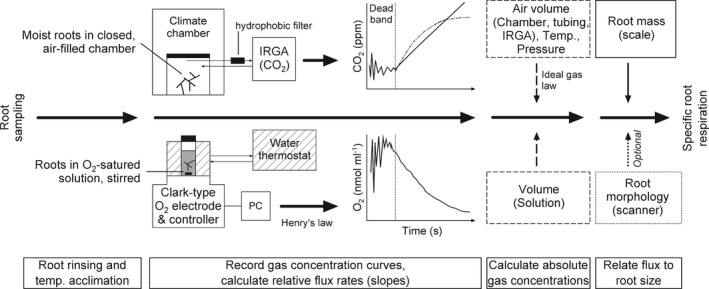Fig. 21.

Typical workflow of specific root respiration (RRS) measurements with closed‐chamber, gas‐phase CO2 (upper) and aqueous‐phase O2 (lower) gas‐exchange systems. (1) Roots are retrieved, rinsed and allowed acclimate to temperature. (2) Roots (or root segments) are inserted into temperature‐controlled, closed chambers to record changes in relative CO2/O2 concentrations, using either an infrared gas analyser (IRGA) or an O2 electrode. A ‘dead band’ illustrates the importance of chamber equilibration (mixing and temperature); subsequently, the slope of the gas concentration curve (δCO2 or δO2/δt; ppm s−1) is calculated by either linear or exponential regressions methods. For gas‐phase measurements, linear regressions often underestimate the slope; for aqueous‐phase O2 measurements, a quasilinear area of the curve is frequently visually selected for slope calculations. (3) The absolute gas concentration (mol m−3) is calculated by using either the ideal gas law (gas‐phase measurements; in retrospect) or Henry’s law (for dissolved gas; often integrated in O2 electrode software) together with information on chamber/solute volume (m3), air pressure (Pa) and temperature (K). (4) Absolute flux rates (µmol s−1) are divided by root dry mass (g), or other size parameters, to calculate RRS (e.g. µmol g−1 s−1). See text for details.
